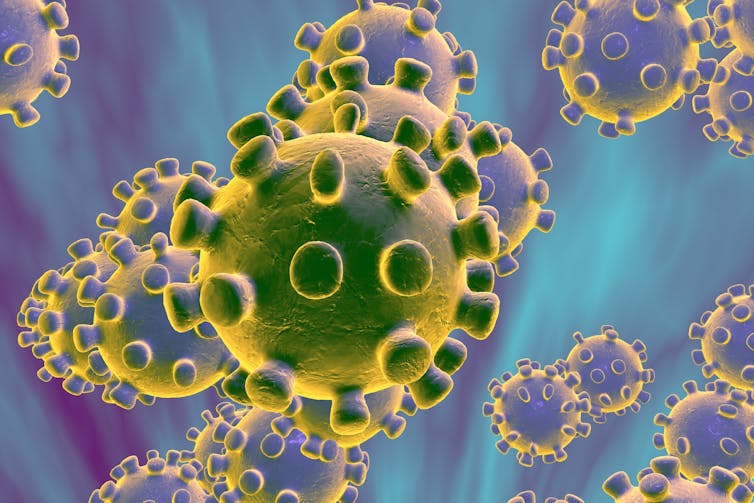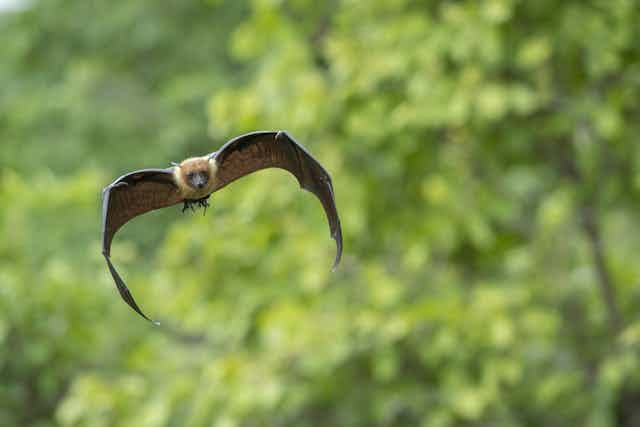In 2003, severe acute respiratory syndrome (SARS) infected a total of 8,098 people worldwide. First reported in China, it spread rapidly through more than two dozen countries in North America, South America, Europe and Asia.
You may not know that bats were implicated as a wildlife “reservoir” of the virus that caused the outbreak and killed 774 people.
SARS was caused by a coronavirus (CoV). Coronaviruses in general infect humans on a regular basis, often leading to symptoms of the common cold: Coughing, sore throat, runny nose, sneezing and fever. But some, like SARS-CoV, jump species to humans from other animals, causing disease and often death.
Bats are believed to be hosts, or reservoirs, for several of these coronaviruses. They are also speculated to be the original source of the Middle East respiratory syndrome (MERS)-CoV that causes an illness, first reported in 2012, from which 30 to 40 per cent of infected patients have died.
And, interestingly, laboratory studies and field observations have shown that bats infected with these viruses do not develop any clinical signs of disease.

Why is this? What adaptations in the bat immune system allow them to survive infections with these viruses? Can they help prevent the next pandemic? These are the questions that drive our research.
Karen Mossman has been studying immune response modulation by viruses for more than 25 years. Arinjay Banerjee is exploring the immune responses in bat and human cells to different viruses, including MERS-CoV, as part of his PhD research.
We hope these studies might open up avenues for identification of novel therapeutics for humans and help us design strategies to increase our odds of surviving infections with these highly pathogenic viruses.
Viruses shut down the immune response
The reason that coronaviruses causing SARS and MERS make us so sick is that, like most other viruses, they have evolved diverse strategies to shut down our first line of defence, the innate immune response.
Immune response is activated when a virus infects the first cell in our body. The cell produces molecules that hinder the spread of the virus. These molecules also prime neighbouring cells to resist infection with the virus.
Inhibiting this immune response is thus an advantage for the virus.

SARS-CoV and MERS-CoV make several proteins that inhibit these cellular defence responses, allowing the virus to spread and the disease to progress in an infected individual.
The ‘jump’ from bats to humans
Viruses such as coronaviruses have likely evolved for a very long time with bats, thus allowing both bats and viruses to reach equilibrium where they can co-exist.
Generally, hosts and viruses that have co-evolved like this adapt their defence and counter-defence strategies to establish an optimal environment for both participants in this evolutionary race.
However, sometimes these viruses grow to high numbers and cause disease or spread from their evolutionary hosts to other animals and to humans if this “optimal” environment is disturbed.

As bats have been evolving for 50 million years, they have had a long time to adapt to their viruses. The question remains then: Why do some of these viruses occasionally “jump” from bats to other species to cause significant disease?
The only mammal capable of true flight
Since coronaviruses similar to MERS-CoV and SARS-CoV have been detected in bats without symptoms, it follows that bats must employ a unique immune response to survive infections.
Bats carry the most viruses per mammalian species, even more than rodents. And bats experimentally infected with MERS-CoV do not develop signs of disease.
Understanding how bats can successfully co-exist with more than 200 different viruses is of growing interest to researchers. Several hypotheses have emerged about this unique ability of bats to resist virus-induced disease. Speculations include co-evolutionary adaptations and the ability to fly.
Bats are the only mammals capable of true flight. During flight, the body temperature of bats rises to over 40°C. This resembles a fever response in humans, and fever is known to prime the immune response.
Is it possible that bats have an immune response that is always primed, in part due to the increase in their body temperatures during flight?
Metabolic rate is also increased during flight, which produces reactive oxygen radicals that can damage cellular DNA. There is evidence that genes involved in antiviral responses are positively selected due to their role in DNA repair as well. Thus, the ability to fly may have caused DNA repair genes to evolve for better functionality, which in turn may have led to the evolution of a more robust immune response in bats.

Scientists also speculate that since bats are primed to resist infections with viruses due to an over-active antiviral response in their cells, their viruses have co-evolved to make increasing amounts of viral proteins that can modulate these immune responses.
When humans are infected with these viruses, the viruses continue to make high levels of these proteins. But human cells are not primed to continuously express high levels of antiviral molecules the way bat cells are. Therefore, immune responses mounted by human cells are probably easily overwhelmed by these viral proteins.
Understanding these intriguing interactions is a work in progress and I am currently trying to understand if MERS-CoV behaves differently in bat cells, with my supervisors Dr. Vikram Misra and Dr. Darryl Falzarano.
We’re also interested in observing how bat cells respond to infection with MERS-CoV and other viruses. We hope these studies will open up avenues for identification of novel therapeutic targets and molecules, and enhance research into less-studied wildlife viral reservoirs.

